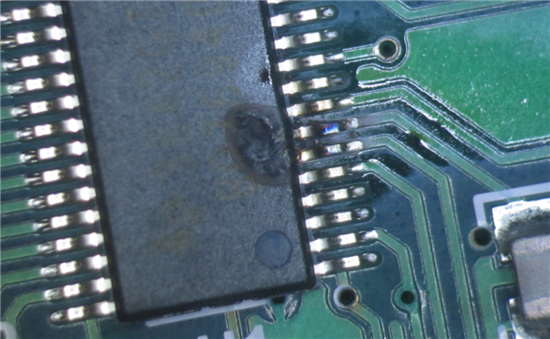Hi,
We are working with the BQ76940 EVM board and the BQ76940 chip on the board just blew. We are fairly confident that it is the LDO that burnt by looking at the image below. When measuring the resistance between BAT+ terminal and pin 7 on the BQ76940 chip, we now get a measurement of 7.7Ohm.
Here is our setup:
BQ76940 EVM
EV2400 connected to either I2C for BQ76940 Eval software or SMBus for BqStudio (ver. 1.3.18)
DC power supply adjustable from 0 to 64V with a current limit set to 2A.
Electronic load set to 1A.
The problems started when we followed the instructions starting on page 9 in the document SLVU925B and we reached step 15. We sent an email to Allen Y Chen to obtain a firmware for the BQ78350, but we had problems installing the firmware. The firmware updater would not recognize the device that was connected and it took several tries to succeed. After the firmware installation was complete, the LEDs (D48-D52) were lit up. The software (bqStudio) would still not recognize the eval board after resetting. The power was turned on for approximately 5 minutes before we saw smoke coming from the chip.
We had 48V set on the DC power supply with the current limit set to 2A. We had an electronic load connected to the PACK terminals (as shown in figure 2 in the document) but the load was not turned on. The voltage measurement on the PACK terminals was between 2.5V and 3.3V. When we turned on the electronic load for just a moment, the voltage would drop to 0V (we had it off when the chip burned).
The previous day, we had no problems. We were using a voltage of 30V and since we didn't have the firmware yet, we were limited to the instructions on page 8 for the AFE quick start. We had the same load connected and we observed the same behavior with the voltage drop when the load was turned on. The BQ76940 Eval software was able to detect the device when connected to the I2C connector with the EV2400
From what we described, is there any possible reason for the chip to burn like that?
Could the load have been turned on inadvertently and we would cause that problem?
Thank you in advance for your help.


